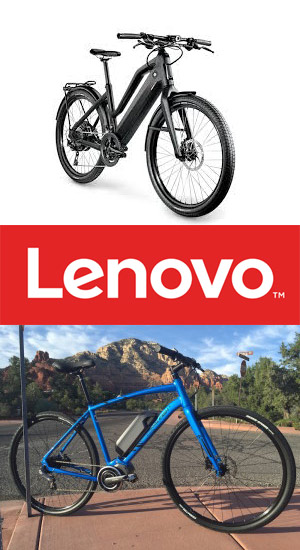
By Gary M. Kaye
Chief content officer, Tech50+ (www.tech50plus.com)
Some of the stars of the recent Interbike Show in Las Vegas, the largest bicycle exhibit in North America, were electric assist bikes, or e-bikes. There were dozens of e-bike companies displaying everything from comfort e-bikes to commuter e-bikes, to mountain e-bikes, even fat tire e-bikes. These machines are ideal for the 50-plus – they provide the joys of bike riding, but dramatically reduce pain and strain. Many have what are called step-through frames –what we used to call women’s bikes – ideal for both bike commuters and those who have lost some range of motion.
Despite their obvious attractions for older riders, so far e-bikes aren’t catching on.
According to Larry Pizzi of Accell NA, the largest e-bike manufacturer in the U.S., and head of the bike industry’s regulatory committee, about 120,000 e-bikes were sold in the U.S. last year. If you add so-called conversion kits that add a motor to an existing bike, that brings the total to about 140,000 – about the number of e-bikes sold in the Netherlands. Compared to the 18 million bikes sold last year in the U.S., e-bike sales could barely be considered a rounding error.
Let me be clear –I am a huge advocate of e-bikes. I have ridden one for five years, enabling me to make biking again the centerpiece of my fitness and leisure life. During foliage season I averaged more than 40 miles each weekend, something that would have left me aching and complaining without the power boost. The e-bike enables me to take on terrain that would have been too challenging, and even better it means I can keep up when riding with my adult sons. So why isn’t the rest of my generation flocking to them?
Regulatory Confusion
Unfortunately there are still U. S. roadblocks to this transportation and recreation revolution already rolling through Europe and Asia. One of the biggest is regulation. While the federal government has detailed its definition of what an e-bike is, their use is still regulated by individual states. Massachusetts says it follows the federal regulation – though some of the state’s regulatory language is confusing if not downright contradictory. As of this writing, ebikes are legal to ride in 27 states, with their status either illegal or unclear in the remainder, though legislation is pending in many states. Part of the issue is definition. Is an e-bike a motor vehicle requiring registration and insurance, or is it a bicycle, which anyone can ride on a public street? California recently enacted legislation separating e-bikes into various categories, including those that must be pedaled to ride, called pedal assist or pedelec, and those that only have a throttle. Pizzi estimates it could take another five years before e-bikes are legal in all states. Though there are very few instances of e-bikers having been issued citations (with the exception of food delivery cyclists in New York City), the regulatory uncertainly has caused some 50-plus riders to shy away.
Sticker Shock
Pricing is another issue. While you can buy a pretty great traditional bike for several hundred dollars, most e-bikes start at about $1,500, though you can find entry level models for about $1,000. They can range up to $10,000. Depending on your income, and what you intend to do with your e-bike, that number can be pretty intimidating. Pricing variables include the range of the bike, the gearing, the build, and the technological sophistication. At Interbike we saw new models from makers like Tempo, Raleigh, I-Zip, and Stromer, that have automatic shifting, and that integrate bike functions and controls into a smartphone app. And just like cars, some folks will want the biking equivalent of a VW Beetle, while others might want a Ferrari.
Fighting For Floor Space
Another reason for the slow adoption of e-bikes has been the resistance of many bike dealers to stocking them. It’s a sort of Catch-22. The bikes are expensive, and the industry isn’t selling a lot of them, so why invest in the inventory and take up precious floor space with unproven products? Most independent bike stores are already crammed with road bikes, mountain bikes, children’s bikes, and even comfort bikes. So adding e-bikes could understandably be considered risky business. And then there’s the service component. Traditional bikes are relatively simple mechanical devices. Not so e-bikes, which have motors, electronics, and even software integration to contend with. It’s all far more akin to an auto service shop these days than a bicycle repair shop.
Last but not least, the bicycle industry has yet to figure out how to market to an older audience. Since they sell millions of bikes to families, to teens, to biking enthusiasts, and to weekend warriors, they’ve never needed to figure out how to get to the Baby Boomer or beyond generations. E-bikes will never be as popular in the U.S. as they are elsewhere in the world, where the price of automobiles and gasoline is far higher than here. So, the potential e-bike commuter population may grow, but without the same economic impetus as elsewhere. That means that the 50-plus generation may be the best bet for e-bikes to succeed, but at the moment, the industry seems a long way from getting itself into gear.
Gary Kaye is the creator of Tech50+ (www.tech50plus.com), the leading website covering technology from the Baby Boomer perspective. Kaye has been covering high tech for more than 30 years with outlets including NBC, ABC, CNN and Fox Business. He is a regular contributor to AARP and other websites on issues regarding the nexus of technology, seniors and baby boomers.